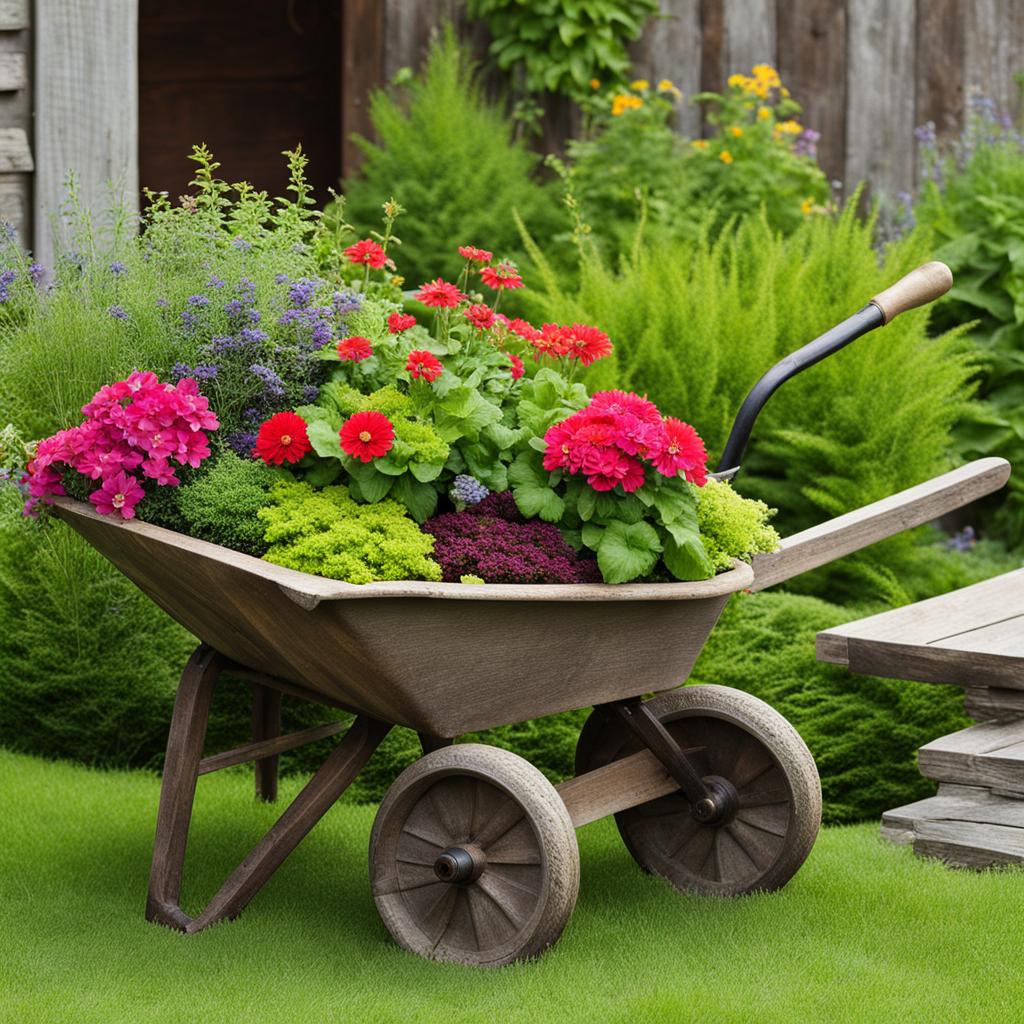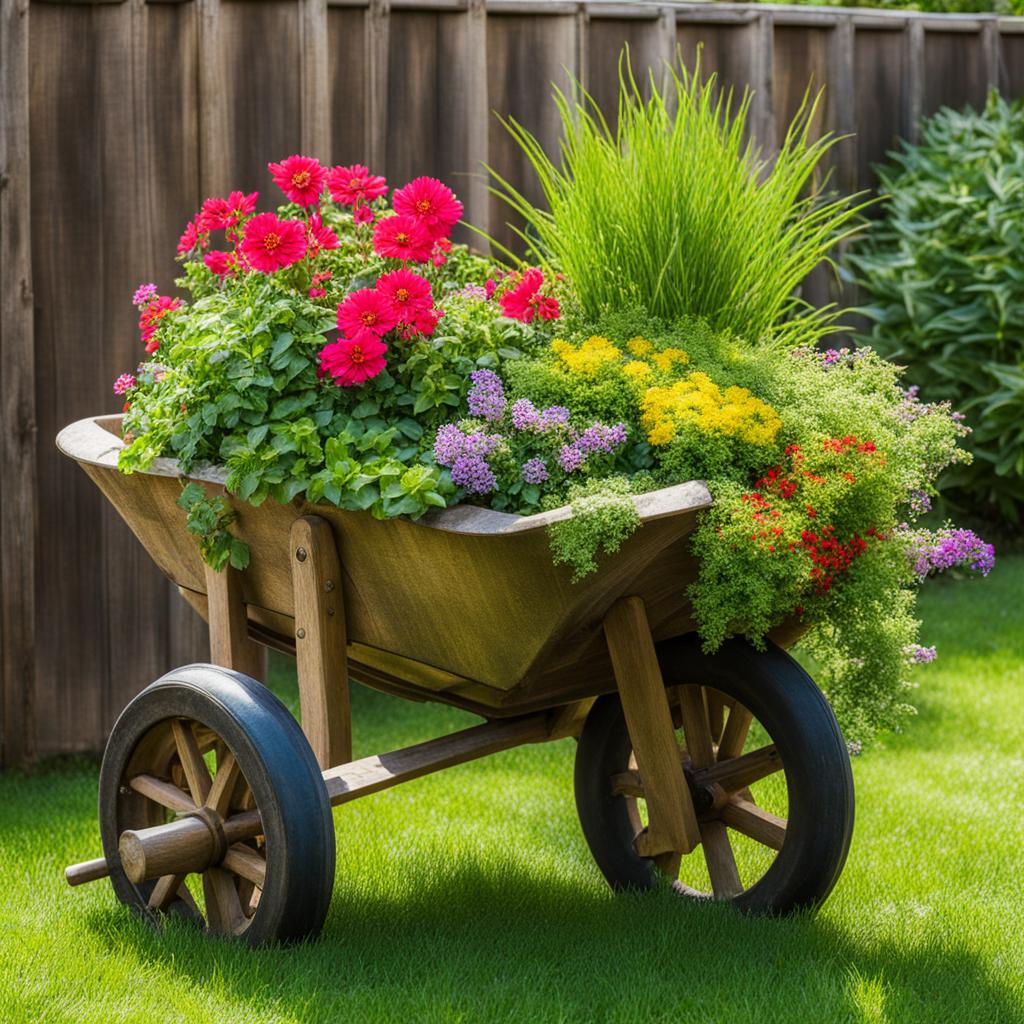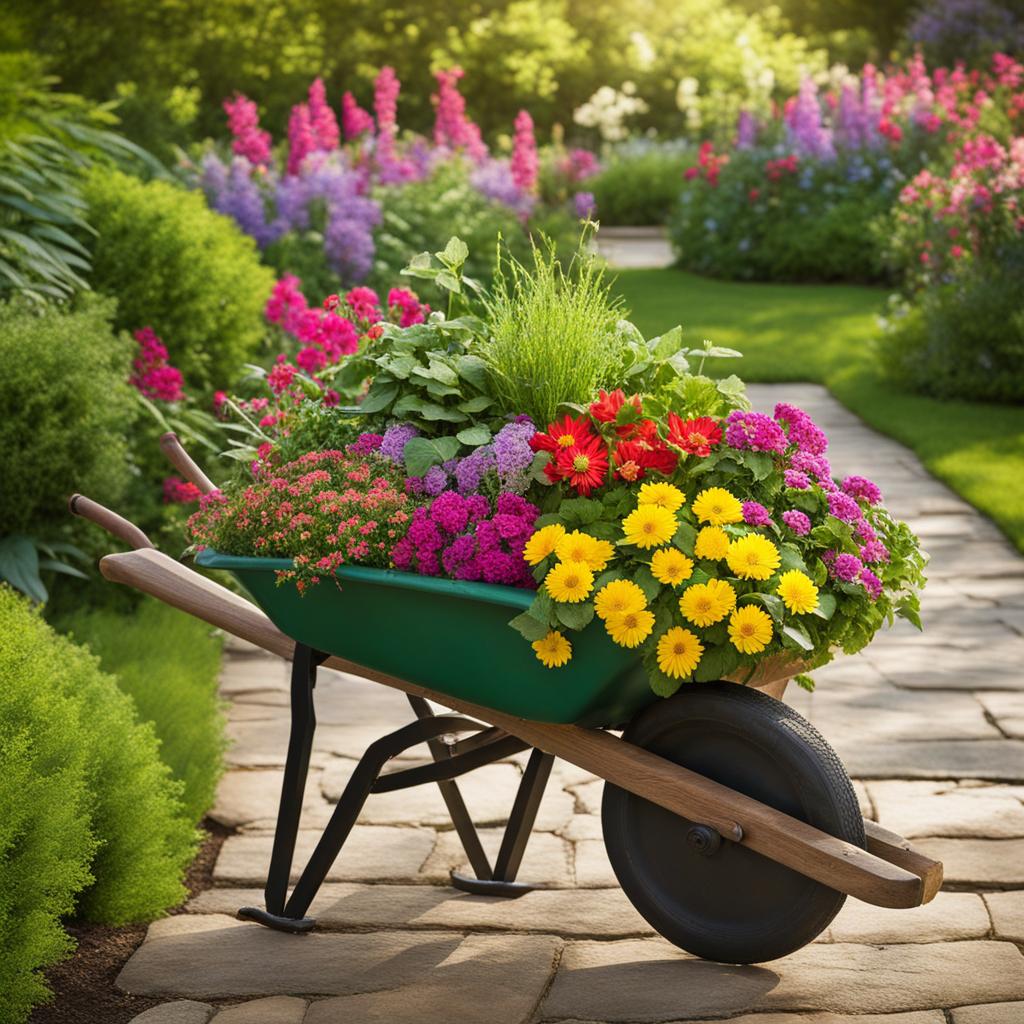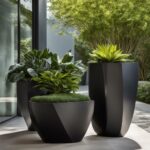Best Plants For Wheelbarrow Planter: Rustic Garden Vibes (2024)
Discover the best plants for a wheelbarrow planter that will bring a rustic charm to your garden. In 2024, I have compiled a list of ideal plants that are perfect for wheelbarrow planters. These plants will add beauty and green-thumbed perfection to your outdoor space.
Key Takeaways
- Choose plants with shallow root systems and compact growth habits for wheelbarrow planters.
- Flowers like petunias, geraniums, and marigolds are great choices for adding color to your wheelbarrow planter.
- Herbs such as basil, thyme, and rosemary can provide both culinary and aromatic benefits in a wheelbarrow planter.
- Succulents are low-maintenance plants that can thrive in wheelbarrow planters with minimal watering.
- Foliage plants like ferns and hostas can add texture and depth to your wheelbarrow planter display.
How to Choose the Right Plants for Your Wheelbarrow Planter
When it comes to selecting plants for your wheelbarrow planter, it’s important to consider a few key factors. By understanding the ideal plants for a wheelbarrow planter, you can create a beautiful and thriving garden display. Here are some tips to help you choose the right plants:
- Size, Shape, and Drainage: Take into account the size and shape of your wheelbarrow planter, as well as its drainage capabilities. Look for plants that have shallow root systems and don’t require a large amount of soil. These plants will thrive in the limited space provided by the planter.
- Weather Tolerance: Opt for plants that can tolerate different weather conditions. This is especially important if your wheelbarrow planter will be exposed to full sun or if you live in an area with harsh winters. Choose plants that can withstand both extreme heat and cold.
- Growth Habit: Consider the growth habit of the plants you choose. Compact or trailing plants are ideal for wheelbarrow planters as they will create a visually appealing arrangement. Avoid plants that have a tendency to grow too tall or spread out too much.
By considering these factors, you’ll be able to select the most suitable plants for your wheelbarrow planter. This will ensure that your plants thrive and look their best, creating a stunning display in your garden.
How to Choose the Right Plants for Your Wheelbarrow Planter
Choosing the ideal plants for a wheelbarrow planter can enhance the overall aesthetics of your garden. Here are some additional tips to help you make the right choices:
- Consider the color palette: Think about the color scheme you want for your wheelbarrow planter. Choose plants that complement each other and create a harmonious blend of colors.
- Mix different plant types: Experiment with a combination of flowers, herbs, succulents, and foliage plants to add variety and texture to your wheelbarrow planter. This will create visual interest and make your planter more visually appealing.
- Think about maintenance: Consider the maintenance requirements of the plants you choose. If you prefer low-maintenance options, opt for succulents or herbs. If you don’t mind regular watering and pruning, go for flowers or foliage plants.
By following these guidelines, you’ll be able to choose plants that not only look great in your wheelbarrow planter but also thrive in their new home. Enjoy the process of selecting and arranging your plants, and watch as your wheelbarrow planter becomes a beautiful focal point in your garden.
Flowers for Wheelbarrow Planters
Flowers are a perfect choice for wheelbarrow planters as they add a burst of colors and fragrance to your garden. Some of the best flowers for wheelbarrow planters include petunias, geraniums, marigolds, and pansies. These plants are known for their vibrant blooms and ability to withstand various weather conditions. They will create a stunning display in your wheelbarrow planter.
Table:
| Flower | Description |
|---|---|
| Petunias | Known for their trumpet-shaped flowers in various colors |
| Geraniums | Produces clusters of colorful blossoms and has a pleasant fragrance |
| Marigolds | Bright and cheerful flowers that come in shades of yellow, orange, and red |
| Pansies | Have velvety petals and come in a wide range of colors |
These flowers not only add visual appeal to your wheelbarrow planter but also attract pollinators like bees and butterflies to your garden. They are easy to care for and will continue to bloom throughout the season, providing you with a beautiful and vibrant garden display.
Remember to choose flowers that are suitable for your specific climate and growing conditions to ensure their successful growth in your wheelbarrow planter.
Herbs for Wheelbarrow Planters
If you’re looking to add some flavor and aroma to your wheelbarrow planter, herbs are the perfect choice. Not only do they provide a beautiful green foliage, but they also offer a variety of culinary uses. Here are some top plants recommended for wheelbarrow planters:
Basil
Known for its distinctive aroma and flavor, basil is a popular herb that thrives in a wheelbarrow planter. It prefers full sun and well-draining soil. Harvest the leaves regularly to encourage new growth and enjoy fresh basil for your favorite recipes.
Thyme
Thyme is a versatile herb that adds a savory flavor to dishes. It is a low-maintenance plant that can tolerate different weather conditions, making it ideal for a wheelbarrow planter. Plant thyme in well-draining soil and place it in a sunny spot to ensure healthy growth.
Rosemary
Rosemary is a fragrant herb that adds a distinct aroma to your garden. It thrives in well-draining soil and requires full sun for optimal growth. With its woody stems and needle-like leaves, rosemary is a visually appealing addition to any wheelbarrow planter.
Parsley
Parsley is a versatile and nutritious herb that can be used in a variety of dishes. It prefers partial shade and moist soil, making it a great option for a wheelbarrow planter. Harvest the leaves as needed and enjoy the fresh flavor of parsley in your culinary creations.
By planting these herbs in your wheelbarrow planter, you’ll not only add beauty and greenery to your garden but also have fresh and flavorful ingredients at your fingertips.
| Herb | Sunlight | Soil | Growing Tips |
|---|---|---|---|
| Basil | Full sun | Well-draining | Regular harvesting |
| Thyme | Full sun | Well-draining | Tolerates different weather conditions |
| Rosemary | Full sun | Well-draining | Woody stems and needle-like leaves |
| Parsley | Partial shade | Moist | Harvest leaves as needed |
Succulents for Wheelbarrow Planters
If you’re looking for low-maintenance plants for your wheelbarrow planter, succulents are a great choice. These versatile plants come in various shapes, sizes, and colors, adding visual interest to your garden. With their unique textures and forms, succulents make a stylish addition to any outdoor space.
Popular succulents for wheelbarrow planters include echeverias, sedums, and haworthias. Echeverias are known for their rosette-shaped leaves and vibrant colors, while sedums offer a variety of textures and growth habits. Haworthias, with their architectural shapes and intricate patterns, add an exotic touch to your garden. These plants require minimal watering and can thrive in dry conditions, making them perfect for a wheelbarrow planter.
When arranging succulents in your wheelbarrow planter, consider combining different varieties to create a dynamic display. Mix and match plants with contrasting colors and textures for a visually striking arrangement. You can also add decorative elements like rocks or driftwood to enhance the natural beauty of the succulents.
Benefits of Succulents for Wheelbarrow Planters
- Succulents are low-maintenance and require minimal watering.
- They come in a wide variety of shapes, sizes, and colors, allowing for creative and unique arrangements.
- Many succulents can thrive in both indoor and outdoor environments.
- They are drought-tolerant and can survive in dry conditions.
- Succulents have a long lifespan and can continue to grow and thrive for many years.
| Succulent Variety | Description |
|---|---|
| Echeveria | Rosette-shaped succulents with vibrant colors |
| Sedum | Offer a variety of textures and growth habits |
| Haworthia | Architectural shapes with intricate patterns |
Foliage Plants for Wheelbarrow Planters
Adding foliage plants to your wheelbarrow planter can bring texture, depth, and a lush green backdrop to your garden. These plants are known for their stunning foliage and ability to thrive in different light conditions. Whether you’re looking for upright ferns, colorful coleus, or elegant hostas, there are plenty of options to choose from. Let’s explore some of my favorite foliage plants for wheelbarrow planters.
Ferns
Ferns are a popular choice for adding a touch of elegance to wheelbarrow planters. Their delicate fronds create a soft and feathery look that beautifully complements other plants. Consider varieties like Boston Fern or Maidenhair Fern for their graceful arching fronds that will cascade over the sides of your planter.
Coleus
Coleus plants are known for their vibrant and eye-catching foliage. With a wide range of colors, patterns, and leaf shapes to choose from, coleus can add a pop of visual interest to your wheelbarrow planter. Mix and match different varieties for a stunning display of contrasting shades and textures.
Hostas
Hostas are versatile perennial plants that thrive in shade or partial shade. Their bold and textured foliage comes in various shades of green, blue, or variegated patterns. The lush leaves of hostas can create a dramatic focal point in your wheelbarrow planter, especially when paired with contrasting flower colors.
| Plant Name | Light Requirements | Height | Special Features |
|---|---|---|---|
| Boston Fern | Partial Shade | Up to 3 feet | Graceful arching fronds |
| Maidenhair Fern | Partial Shade | Up to 1 foot | Delicate and lacy fronds |
| Coleus | Partial Shade to Full Sun | Varies depending on variety | Vibrant foliage colors |
| Hostas | Shade to Partial Shade | Varies depending on variety | Textured leaves in different colors |
Remember to choose foliage plants that are suitable for the light conditions in your garden and the size of your wheelbarrow planter. Also, consider the growth habit of each plant to ensure they won’t outgrow the space. By incorporating foliage plants into your wheelbarrow planter, you’ll create a vibrant and visually appealing garden display that will impress all who see it.
Tips for Planting in Wheelbarrow Planters
Planting in wheelbarrow planters can be a fun and creative way to showcase your favorite plants. To ensure successful growth and a visually appealing arrangement, here are some tips to keep in mind:
1. Provide Proper Drainage:
Drill holes in the bottom of the wheelbarrow to allow excess water to escape. This will prevent waterlogged soil and ensure that your plants don’t suffer from root rot. Good drainage is crucial for the health of your plants.
2. Use Quality Potting Mix:
Choose a high-quality potting mix that retains moisture but also drains well. Avoid using garden soil or compost alone, as they can compact and inhibit root growth. A good potting mix will provide the necessary nutrients and aeration for your plants to thrive.
3. Plan Your Plant Placement:
Consider the height and growth habit of your plants when arranging them in the wheelbarrow planter. Place taller plants at the back to create a focal point, and cascading or trailing plants at the front to add depth and visual interest. This will help create a balanced and aesthetically pleasing display.
4. Regular Watering and Fertilizing:
Water your plants regularly, keeping in mind their specific water requirements. Check the moisture level of the soil by sticking your finger about an inch deep into the soil. If it feels dry, it’s time to water. Additionally, fertilize your plants according to their needs to promote healthy growth and vibrant blooms.
By following these tips, you can ensure that your plants thrive and your wheelbarrow planter becomes a focal point in your garden. Get creative with your plant selection and design, and enjoy the beauty of your unique garden display.
Wheelbarrow Planter Maintenance
Maintaining your wheelbarrow planter is essential to ensure its longevity and keep your plants thriving. Regular upkeep will help prevent rust, damage, and other issues that can affect both the planter and the plants it houses. Here are some maintenance tips to keep your wheelbarrow planter in top condition:
Inspect and Clean Regularly
Regularly inspect your wheelbarrow planter for any signs of rust, dents, or loose handles. If you notice any damage, make repairs promptly to prevent further deterioration. Clean the planter regularly by removing dirt, debris, and weeds to maintain its appearance and prevent any potential harm to your plants.
Protect Against Extreme Weather
During heavy rain or snowfall, consider moving your wheelbarrow planter to a sheltered area to protect it from excessive moisture. This will prevent waterlogging and ensure the proper drainage required for your plants’ health. Additionally, extreme sun exposure can fade the planter’s color and affect its structural integrity, so providing shade during peak hours can help prolong its lifespan.
Apply Protective Coating
To prevent rust and corrosion, consider applying a protective sealant or coating to your wheelbarrow planter. This will create a barrier against moisture and other environmental elements that can contribute to deterioration. Choose a sealant that is suitable for the material of your planter, such as metal or wood, and apply it according to the manufacturer’s instructions.
Remember that regular maintenance is key to preserving the beauty and functionality of your wheelbarrow planter. By taking the time to inspect, clean, and protect your planter, you can enjoy its charm and the lushness of your plants for years to come.
Creative Wheelbarrow Planter Ideas
When it comes to wheelbarrow planters, the possibilities are endless. You can unleash your creativity and make a unique statement in your garden. Here are some creative wheelbarrow planter ideas to inspire you:
- Paint it Vibrant: Transform your wheelbarrow planter with a fresh coat of vibrant paint. Choose bold colors like turquoise, yellow, or fuchsia to create a striking visual impact in your garden.
- Add Decorative Accents: Personalize your wheelbarrow planter by adding decorative accents. Consider attaching decorative handles, metal trims, or stenciling patterns to enhance its charm.
- Incorporate Fairy Lights: Create a magical ambiance by incorporating fairy lights into your wheelbarrow planter. Wrap them around the handles or weave them through the plants to illuminate your garden at night.
- Plant a Theme Garden: Use the wheelbarrow planter as a centerpiece for a themed garden. For example, create a herb garden by planting different types of herbs, or a succulent garden with a variety of colorful succulents.
- Stack Multiple Wheelbarrows: If you want to make a statement, stack multiple wheelbarrows of different sizes. Fill each level with plants of your choice and create a stunning vertical garden display.
Get creative and let your imagination run wild with these wheelbarrow planter ideas. Whether you opt for a vibrant paint job, incorporate decorative accents, or plant a themed garden, your wheelbarrow planter will become a unique focal point in your garden.
Remember to consider the overall aesthetic of your garden and choose ideas that complement your existing landscaping. Have fun experimenting with different designs and enjoy the beauty that a creative wheelbarrow planter brings to your outdoor space.
Wheelbarrow Planter Placement
Choosing the right placement for your wheelbarrow planter is crucial to ensure that your plants thrive and your garden looks its best. Consider these tips when deciding where to place your wheelbarrow planter:
- Assess the sun and shade requirements of your chosen plants: Some plants prefer full sun, while others thrive in partial shade. Place your wheelbarrow planter in an area that provides the appropriate amount of sunlight for the plants you have selected.
- Ensure proper drainage: Drill holes in the bottom of the wheelbarrow to allow excess water to escape. This will prevent waterlogged soil and root rot, keeping your plants healthy.
- Consider visibility and accessibility: Choose a location where your wheelbarrow planter can be easily seen and admired. This can be near a seating area, along a garden path, or as a focal point in your yard.
- Provide enough space: Make sure there is enough room for the wheelbarrow planter to fit comfortably without overcrowding other plants or structures. The size and scale of the wheelbarrow should be proportional to its surroundings.
By considering these factors, you can find the perfect spot for your wheelbarrow planter, creating an eye-catching display and adding charm to your garden landscape.
Table: Placement Considerations
| Considerations | Tips |
|---|---|
| Sun and shade requirements | Place the wheelbarrow planter in an area that provides the appropriate amount of sunlight for the plants you have selected. |
| Drainage | Ensure proper drainage by drilling holes in the bottom of the wheelbarrow. |
| Visibility and accessibility | Choose a location where the wheelbarrow planter can be easily seen and admired. |
| Space | Make sure there is enough room for the wheelbarrow planter to fit comfortably without overcrowding other plants or structures. |
DIY Wheelbarrow Planter
If you’re feeling creative and want to add a personal touch to your garden, making your own wheelbarrow planter is a fun and rewarding project. With just a few materials and some basic woodworking skills, you can create a unique and charming centerpiece for your outdoor space.
To start, you’ll need an old wheelbarrow or the materials to build a faux wheelbarrow. If you have an old wheelbarrow, make sure it’s sturdy and in good condition. If not, you can build a wheelbarrow using wood, nails, and screws. There are plenty of DIY tutorials available online that provide step-by-step instructions for building a wheelbarrow planter.
Once you have your wheelbarrow, it’s time to get creative with the design. You can paint the wheelbarrow in your favorite colors or add decorative accents like stencils or decals. Consider adding a weatherproof sealant to protect the wood and enhance the durability of your planter.
When it comes to planting in your DIY wheelbarrow planter, the possibilities are endless. You can choose to plant flowers, herbs, succulents, or foliage plants, depending on your preferences and the look you want to achieve. Just make sure to provide proper drainage by drilling holes in the bottom of the wheelbarrow and using a high-quality potting mix.

Creating your own wheelbarrow planter allows you to showcase your creativity and personality in your garden. It’s a fantastic way to add a touch of rustic charm and make a statement with your outdoor decor. Whether you’re a seasoned DIY enthusiast or just starting, building a wheelbarrow planter is a project that anyone can tackle.
Seasonal Planting Ideas for Wheelbarrow Planters
Adding seasonal plants to your wheelbarrow planter is a great way to keep your garden looking fresh and vibrant throughout the year. By choosing plants that thrive in different seasons, you can create a constantly changing display that adds visual interest and variety. Here are some seasonal planting ideas for your wheelbarrow planter:
Spring:
- Tulips: These colorful flowers bring a burst of beauty to your wheelbarrow planter in spring. Choose from a variety of vibrant hues to create a stunning display.
- Daffodils: Known for their bright yellow blooms, daffodils add a cheerful touch to your wheelbarrow planter. They are also easy to grow and require minimal maintenance.
- Pansies: With their velvety petals and wide range of colors, pansies are a popular choice for spring plantings. They can tolerate cooler temperatures, making them ideal for early spring displays.
Summer:
- Petunias: These heat-tolerant flowers come in a wide array of colors and are perfect for adding a pop of color to your wheelbarrow planter in the summer months.
- Zinnias: Known for their vibrant blooms, zinnias are a popular choice for summer gardens. They come in various shades of red, orange, pink, and yellow, adding a bold and cheerful touch to your wheelbarrow planter.
- Begonias: With their lush foliage and delicate flowers, begonias are a beautiful addition to your wheelbarrow planter. They thrive in the shade and are perfect for creating a cool and tranquil oasis in your garden.
Fall:
- Mums: Fall wouldn’t be complete without the vibrant blooms of chrysanthemums. These hardy flowers come in a variety of colors and add a cozy, autumnal feel to your wheelbarrow planter.
- Ornamental Grasses: To add texture and movement to your wheelbarrow planter, consider planting ornamental grasses. Their feathery plumes and golden hues create a stunning display in the fall.
Winter:
- Evergreens: For year-round greenery in your wheelbarrow planter, choose evergreen plants like pine, cedar, or juniper. Not only do they provide color during the winter months, but they also provide a beautiful backdrop for other seasonal decorations.
- Holly: The bright red berries and glossy green leaves of holly plants make them a festive addition to your wheelbarrow planter during the holiday season. They add a touch of traditional charm to your garden.
By incorporating seasonal plants into your wheelbarrow planter, you can transform it into a stunning focal point that changes with the seasons. Whether you prefer vibrant flowers, textured grasses, or evergreen foliage, there is a perfect plant for every time of year. Get creative and enjoy the beauty that seasonal planting brings to your garden.
| Season | Planting Ideas |
|---|---|
| Spring | Tulips, Daffodils, Pansies |
| Summer | Petunias, Zinnias, Begonias |
| Fall | Mums, Ornamental Grasses |
| Winter | Evergreens, Holly |
Table: Seasonal Planting Ideas for Wheelbarrow Planters
Incorporating Wheelbarrow Planters in Small Gardens
If you have a small garden, wheelbarrow planters can be a space-saving solution. They can be placed in corners, on patios, or even hung on walls or fences. Utilize vertical space by stacking multiple wheelbarrow planters. This allows you to grow a variety of plants without taking up too much ground space. Wheelbarrow planters bring a unique and charming element to small gardens.
When using a wheelbarrow planter in a small garden, consider the size and shape of the planter. Opt for a compact wheelbarrow that fits well within the limited space. You can also choose planters with built-in trellises, allowing you to grow vines or climbing plants vertically. This maximizes growing space while still adding visual interest to your garden.
Choosing the Right Plants
When selecting plants for a small garden wheelbarrow planter, choose those that are well-suited for compact spaces. Look for plants with a small growth habit or dwarf varieties that won’t overpower the planter. Consider plants that can be trained to grow upright or cascading plants that will spill over the sides of the wheelbarrow, adding dimension to your garden.
- Herbs like basil, thyme, and mint are perfect for small wheelbarrow planters. They are compact and can be easily harvested for culinary use.
- Succulents, such as sedums and echeverias, are low-maintenance and don’t require much space. They add a touch of greenery and texture to your garden.
- Flowering plants like geraniums, begonias, and impatiens provide bursts of color and can be planted in small groups for a vibrant display.
Creative Placement Ideas
Incorporating wheelbarrow planters in small gardens allows for creative placement options. Place them strategically to enhance the overall aesthetics of your garden. Here are a few placement ideas to consider:
- Hang a wheelbarrow planter on a garden fence or wall to create a vertical garden. This is particularly useful for small gardens with limited ground space.
- Position a wheelbarrow planter in a corner, surrounded by tall plants or trellises, to create a cozy and secluded area in your garden.
- Place a wheelbarrow planter on a patio or deck, adding a touch of greenery and charm to your outdoor living space.
By incorporating wheelbarrow planters in small gardens, you can maximize your growing space and add a unique focal point to your outdoor area. Get creative with your placement and plant selection to create a stunning garden display in even the smallest of spaces.
Wheelbarrow Planter Maintenance Tips
Maintaining your wheelbarrow planter is essential to ensure its longevity and keep it looking its best. Here are some maintenance tips to help you take care of your wheelbarrow planter:
Regular Inspections
Inspect your wheelbarrow planter regularly for any signs of damage or wear. Check for loose handles, wheels, or any rust spots. Repair or replace any damaged parts promptly to prevent further deterioration.
Protective Sealant
Apply a protective sealant to the exterior of your wheelbarrow planter to prevent rust and corrosion. This will help extend its lifespan and keep it looking beautiful. Make sure to choose a sealant that is suitable for outdoor use and follow the manufacturer’s instructions for application.
Cleaning
Clean your wheelbarrow planter regularly to remove dirt, debris, and any built-up residue. Use a mild detergent and a soft brush or cloth to gently scrub the surface. Rinse thoroughly with water and allow it to dry completely before adding new plants or soil.

Proper Storage
During extreme weather conditions, such as heavy rain, snow, or harsh sunlight, consider moving your wheelbarrow planter to a sheltered area to protect it from damage. This will help prevent fading, warping, or other issues caused by exposure to the elements. If possible, store it in a garage, shed, or covered patio when not in use.
By following these maintenance tips, you can ensure that your wheelbarrow planter remains in excellent condition and continues to enhance the beauty of your garden for years to come.
Enhancing Your Garden with Wheelbarrow Planters
Adding wheelbarrow planters to your garden can elevate its aesthetics and bring a whimsical and rustic touch to the overall design. These unique planters serve as standalone features or can be incorporated into a larger garden layout, creating a charming focal point that catches the eye. By carefully selecting the right plants and providing proper care and maintenance, you can enhance the beauty of your outdoor space with a wheelbarrow planter.
One way to enhance your garden with a wheelbarrow planter is by choosing plants that complement the overall theme and atmosphere you want to create. For a vibrant and colorful display, opt for flowers such as petunias, geraniums, and marigolds. These plants not only add a burst of colors but also attract pollinators, making your garden come alive with buzzing activity.
If you prefer a more subtle and natural look, foliage plants like ferns, coleus, and hostas can add texture and depth to your wheelbarrow planter. Their lush leaves create a visually appealing backdrop for other plants and help create a serene and calming atmosphere in your garden.
| Plant Type | Plant Examples |
|---|---|
| Flowers | Petunias, Geraniums, Marigolds |
| Herbs | Basil, Thyme, Rosemary, Parsley |
| Succulents | Echeverias, Sedums, Haworthias |
| Foliage Plants | Ferns, Coleus, Hostas |
Table: Examples of Plants for Wheelbarrow Planters
When arranging the plants in your wheelbarrow planter, consider the height and growth habits of each plant. Place taller plants towards the back of the planter and cascading or trailing plants towards the front. This creates a visually appealing arrangement that showcases each plant’s unique features.
Remember to regularly water and fertilize your plants to promote healthy growth and vibrant blooms. Additionally, inspect your wheelbarrow planter regularly for any signs of wear or damage. Repair or repaint as needed to ensure that it remains in good condition and continues to enhance your garden for years to come.
Conclusion
In conclusion, wheelbarrow planters offer a charming and rustic way to showcase your favorite plants in the garden. By selecting the best plants for wheelbarrow planters and taking proper care, you can create a stunning and unique garden display. Whether you prefer flowers, herbs, succulents, or foliage plants, there is a perfect plant for your wheelbarrow planter.
When choosing plants for your wheelbarrow planter, consider their size, shape, and ability to tolerate different weather conditions. Flowers like petunias, geraniums, marigolds, and pansies will add a burst of color and fragrance to your garden. Herbs such as basil, thyme, rosemary, and parsley not only provide delicious additions to your cooking but also have a lovely aroma.
If you prefer low-maintenance options, succulents like echeverias, sedums, and haworthias are a great choice. They come in various shapes and colors, adding visual interest to your garden. Foliage plants like ferns, coleus, and hostas can bring texture and depth to your wheelbarrow planter.
With proper care and maintenance, your wheelbarrow planter will continue to enhance the aesthetics of your outdoor space. Regularly check for any signs of damage or rust, clean out debris and weeds, and ensure proper drainage. By following these tips and getting creative with your design, you can enjoy the beauty and charm that a wheelbarrow planter brings to your garden.
FAQ
What factors should I consider when choosing plants for a wheelbarrow planter?
When selecting plants for your wheelbarrow planter, consider the size, shape, and drainage characteristics of the container. Look for plants with shallow root systems that do not require a large amount of soil. Opt for plants that can tolerate different weather conditions and have a compact growth habit.
What are some of the best flowers for wheelbarrow planters?
Some of the best flowers for wheelbarrow planters include petunias, geraniums, marigolds, and pansies. These plants are known for their vibrant blooms and ability to withstand various weather conditions.
Can I plant herbs in a wheelbarrow planter?
Yes, herbs like basil, thyme, rosemary, and parsley can thrive in a wheelbarrow planter. They are not only delicious additions to your cooking but also have a lovely aroma.
What are some low-maintenance plant options for a wheelbarrow planter?
Succulents are a great choice for low-maintenance plants in a wheelbarrow planter. Popular succulents for wheelbarrow planters include echeverias, sedums, and haworthias.
What types of foliage plants can I use in a wheelbarrow planter?
Ferns, coleus, and hostas are great options for foliage plants in a wheelbarrow planter. They provide texture and depth to your display.
How should I plant in a wheelbarrow planter?
It’s important to provide proper drainage by drilling holes in the bottom of the wheelbarrow. Use a high-quality potting mix that retains moisture but also drains well. Place taller plants at the back and cascading plants at the front for a visually appealing arrangement.
How do I maintain a wheelbarrow planter?
Regularly check for rust and repair or repaint as needed. Clean out any debris or weeds that may accumulate in the planter. During extreme weather conditions, consider moving the planter to a sheltered area to protect the plants.
What are some creative ideas for a wheelbarrow planter?
Consider painting the wheelbarrow in vibrant colors or adding decorative accents. You can also incorporate other elements like fairy lights or small garden statues to create a unique focal point.
Where should I place my wheelbarrow planter?
Consider the sun and shade requirements of your plants when choosing a placement. Most flowers and herbs prefer full sun, while some foliage plants can tolerate partial shade. Ensure the area has proper drainage and enough space for the planter.
Can I make my own wheelbarrow planter?
Yes, you can repurpose an old wheelbarrow or create a faux wheelbarrow using wood or other materials. There are numerous DIY tutorials available online to guide you through the process.
How can I change the plants in my wheelbarrow planter with the seasons?
In spring, plant tulips, daffodils, and pansies. In summer, opt for vibrant annual flowers like petunias, zinnias, and begonias. Fall is perfect for mums and ornamental grasses. In winter, evergreen plants and holly can add a festive touch.
Can I use a wheelbarrow planter in a small garden?
Yes, wheelbarrow planters can be a space-saving solution for small gardens. They can be placed in corners, on patios, or even hung on walls or fences. You can also stack multiple wheelbarrow planters to utilize vertical space.
How do I maintain my wheelbarrow planter?
Regularly check for any signs of damage or deterioration. Repair loose handles or wheels, and apply a protective sealant to prevent rust. Clean the wheelbarrow regularly to remove dirt and debris.
How can wheelbarrow planters enhance my garden?
Wheelbarrow planters add a whimsical and rustic touch to your garden. They can be standalone features or part of a larger garden design, creating a beautiful focal point in your outdoor space.







